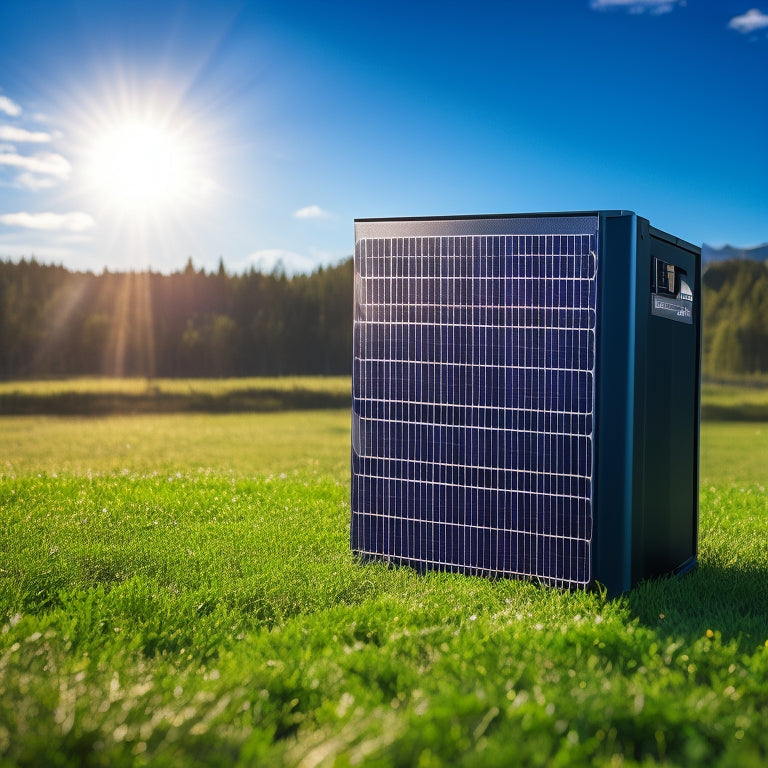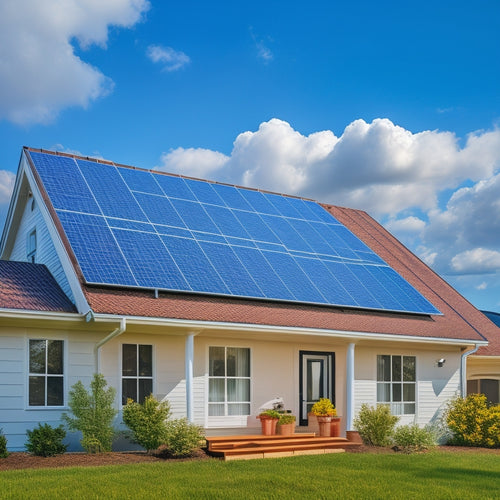
What Makes Solar Power Inverters Efficient
Share
Solar power inverters achieve efficiency primarily through advanced energy conversion technologies like Maximum Power Point Tracking (MPPT) that enhance energy harvest under varying conditions. They maintain high efficiency ratings, typically between 95% and 98%, minimizing energy loss. Operating these inverters within ideal temperature ranges boosts performance, while compatibility with different solar panel types reduces mismatch losses. Additionally, their design guarantees lower total harmonic distortion, yielding cleaner output. Ultimately, these factors lead to significant long-term savings and reduced maintenance. Exploring how specific technologies impact overall efficiency could provide you with even greater perspectives.
At a Glance
- High-quality inverters with Maximum Power Point Tracking (MPPT) algorithms optimize energy harvest under varying conditions, enhancing overall efficiency.
- Inverter efficiency ratings typically range from 95% to 98%, indicating minimal energy loss during conversion.
- Maintaining optimal operating conditions, including temperature control, is crucial for maximizing inverter performance.
- Advanced inverter technologies, like microinverters and power optimizers, improve energy output and reliability, particularly in shaded environments.
- Reduced maintenance needs and long-term energy savings make high-efficiency inverters a cost-effective choice over their lifespan.
Maximized Energy Conversion Rates
To maximize energy conversion rates, you need to stay informed about the latest advancements in inverter technology.
High-quality inverters, equipped with MPPT algorithms, enhance efficiency under various operating conditions, ensuring peak performance.
Inverter Technology Advancements
Recent advancements in inverter technology have greatly enhanced energy conversion rates, making solar power systems more efficient than ever. These innovations focus on refining the way inverters interact with other system components, guaranteeing maximum output from your solar panels. Improved algorithms allow inverters to adapt to varying sunlight conditions, which means they can adjust in real-time for peak performance.
Furthermore, smart grid integration plays a vital role in these advancements. Inverters now communicate seamlessly with the grid, allowing for efficient energy distribution and reducing losses during transmission. This integration not only enhances energy conversion but also supports grid stability, enabling homeowners and businesses to contribute to a more resilient energy environment.
Additionally, the incorporation of advanced energy storage solutions complements these developments. By integrating storage capabilities, inverters can manage excess energy generated during peak production times, storing it for later use.
This flexibility maximizes energy utilization and guarantees that you have access to power when you need it most, reducing reliance on the grid.
Optimal Operating Conditions
Maximized energy conversion rates depend heavily on the ideal operating conditions of solar power inverters. To achieve maximum efficiency, you need to take into account factors such as temperature effects and load variations. Each of these elements can greatly influence the inverter's performance and its ability to convert solar energy into usable power.
Here's a quick reference table to illustrate the impact of these factors:
| Factor | Impact on Efficiency |
|---|---|
| Temperature Effects | High temperatures can lead to reduced efficiency, as inverters may throttle output to prevent overheating. |
| Load Variations | Inverters perform best at specific load levels; considerable deviations can lower conversion rates. |
Understanding these processes is essential for maximizing your solar energy system's potential. By keeping your inverter within its maximum temperature range and matching it to expected load variations, you can enhance its performance and guarantee that you're utilizing the most energy possible. Ultimately, the more you know about these operating conditions, the better you can fine-tune your solar setup for freedom from traditional energy sources.
Cost Savings Over Time
When you invest in high-efficiency solar power inverters, you're not just enhancing energy conversion; you're also setting yourself up for significant long-term energy savings.
These systems typically require less maintenance, which translates into reduced expenses over time.
Additionally, utilizing battery backup systems can further enhance your energy independence and protect against outages.
Long-term Energy Savings
Investing in solar power inverters not only enhances energy conversion efficiency but also leads to significant cost savings over time. By opting for high-quality inverters, you're making a long-term investment in your energy future. These devices maximize the amount of energy harvested from your solar panels, translating into lower electricity bills and increased energy autonomy.
When you choose efficient inverters, you're not just saving money; you're also making sustainable choices that contribute to a greener planet. Over the lifespan of your solar system, which can exceed 25 years, the cumulative savings from reduced energy costs can be substantial. In fact, many users report a return on investment that far exceeds traditional energy sources.
Moreover, efficient inverters can help you avoid potential energy losses, which can otherwise diminish your savings. By ensuring peak performance, these inverters enable you to utilize the maximum potential of your solar array.
As you adopt solar technology, you'll find that the initial costs fade in comparison to the long-term financial benefits, enabling you to enjoy the freedom that comes with energy independence.
Reduced Maintenance Expenses
A key advantage of using high-efficiency solar power inverters is the reduced maintenance expenses they offer over time. With these inverters, you'll find that the need for frequent repairs diminishes considerably. This reduction can be attributed to their advanced design and superior materials, which enhance operational longevity. As a result, you'll spend less on unplanned maintenance costs, allowing you to allocate resources elsewhere.
Preventive maintenance becomes more straightforward and cost-effective as well. High-efficiency inverters typically require less frequent servicing, meaning you can schedule maintenance intervals that align with your operational needs. This proactive approach not only saves you money but also guarantees peak performance throughout the system's lifespan.
Moreover, with fewer parts subject to wear and tear, your overall maintenance burden decreases. You benefit from not only reduced costs but also increased reliability in your solar power system.
Key Specifications Overview
When evaluating solar power inverters, you'll want to focus on inverter efficiency ratings and conversion performance factors.
These specifications directly impact how effectively the inverter alters solar energy into usable electricity.
Additionally, considering the benefits of integrated systems can provide a comprehensive view of energy management solutions.
Understanding these metrics will help you make informed decisions about your solar investment.
Inverter Efficiency Ratings
Inverter efficiency ratings serve as a significant benchmark for evaluating the performance of solar power inverters. These ratings, typically expressed as a percentage, indicate how effectively an inverter converts DC electricity from solar panels into usable AC electricity. A higher efficiency rating means less energy loss during this conversion, directly impacting your overall energy yield.
When evaluating inverter efficiency, it's essential to take into account solar panel compatibility. Not all inverters work well with every solar panel type, and mismatched systems can lead to suboptimal performance. A compatible inverter maximizes energy output, ensuring you get the most from your solar investment.
Additionally, you should factor in inverter lifespan. An efficient inverter not only delivers better performance but can also extend its operational life. Inverters with higher efficiency ratings tend to withstand operational stresses better, resulting in fewer replacements over time.
Ultimately, focusing on inverter efficiency ratings helps you choose a system that aligns with your energy goals and financial freedom. By prioritizing efficiency, compatibility, and longevity, you can optimize your solar power setup for sustainable energy independence.
Conversion Performance Factors
While various factors influence the conversion performance of solar power inverters, key specifications such as total harmonic distortion (THD), maximum power point tracking (MPPT) efficiency, and temperature coefficient play vital roles.
THD measures waveform quality, which is essential for maintaining grid compatibility and ensuring efficient power delivery. A lower THD indicates a cleaner output, enhancing overall system performance.
MPPT efficiency is important for optimizing energy harvest; it flexibly adjusts the inverter's operation to match varying input voltage and load conditions, maximizing energy conversion.
Temperature effects can greatly impact performance; inverters can lose efficiency at high temperatures. The temperature coefficient quantifies this loss, guiding your component selection. A well-designed system considers these factors, ensuring effective load matching and minimizing energy waste.
Proper installation practices also enhance conversion efficiency. Neglecting aspects like wiring and grounding can lead to increased losses.
By focusing on these key specifications and understanding their interplay, you can achieve a solar power system that not only meets your energy needs but also offers long-term reliability and performance.
Prioritize these conversion performance factors in your system design to release the true potential of solar energy.
Selecting Based on Efficiency Ratings
When selecting a solar power inverter, it's vital to understand efficiency ratings as they directly impact system performance.
Inverter efficiency greatly influences overall battery performance and energy output, so evaluating options is necessary for optimizing your system.
You'll want to compare different inverter technologies to find the best fit for your energy needs and budget.
Analyzing these factors will guarantee you make an informed decision that maximizes your solar investment while considering inverter compatibility and selection.
Understanding Efficiency Ratings
Efficiency ratings play an essential role in selecting the right solar power inverter for your system. These ratings indicate how effectively an inverter converts DC electricity generated by your solar panels into usable AC electricity.
A higher efficiency rating means less energy loss during the conversion process, which directly impacts your overall energy production and savings.
When evaluating efficiency ratings, look for the maximum efficiency percentage, typically ranging from 95% to 98%. This figure represents the inverter's ability to minimize energy loss, ensuring that most of the solar energy generated translates into usable power.
Additionally, consider the European Efficiency (EU) rating, which provides a more realistic measure of performance under various conditions.
Comparing Inverter Technologies
Choosing the right inverter technology can greatly influence your solar power system's performance and overall efficiency. When comparing inverter technologies, it's vital to assess their efficiency ratings, which directly affect energy output.
You'll typically encounter string inverters, microinverters, and power optimizers, each with distinct advantages. String inverters are often the most cost-effective option, but they may struggle with shading issues and require careful installation considerations.
On the other hand, microinverters provide superior performance in shaded conditions and allow for easier monitoring, but they generally come at a higher price point. Power optimizers combine features of both, enhancing energy harvest while maintaining grid compatibility.
When selecting an inverter, consider how well it integrates with your existing grid setup. This guarantees maximum energy utilization and compliance with local regulations.
Additionally, evaluate installation requirements, as some technologies may necessitate specialized skills, impacting overall costs. Ultimately, assessing these factors will enable you to choose an inverter that aligns with your efficiency goals and freedom to utilize solar energy effectively.
Higher Reliability in Performance
When you evaluate solar power inverters, consider how enhanced energy conversion efficiency contributes to reliability in performance.
Higher efficiency means less energy loss during the conversion process, which directly impacts the overall effectiveness of your solar system.
This reliability not only maximizes energy output but also guarantees consistent performance over time.
Enhanced Energy Conversion Efficiency
Achieving enhanced energy conversion efficiency in solar power inverters is vital for maximizing performance and reliability. You want your inverter to harness the energy harvested from solar panels, guaranteeing that every photon counts. High efficiency translates to lower energy losses during conversion, which is essential when integrating with the grid.
To improve energy conversion efficiency, consider factors like solar panel compatibility. Inverters must be matched with the right panels to minimize mismatch losses, which can markedly reduce overall system performance. A well-configured system guarantees that the inverter operates within its ideal voltage and current range, improving its ability to convert DC to AC power effectively.
Grid integration further impacts efficiency. Inverters with advanced grid management features can adapt to varying grid conditions, maintaining performance stability even during disruptions. This adaptability not only enhances efficiency but also increases reliability, guaranteeing a steady power supply to your home or business.
Frequently Asked Questions
How Do Environmental Factors Affect Solar Inverter Efficiency?
Environmental factors, like temperature impact and humidity effects, greatly influence your solar inverter's efficiency. High temperatures can reduce performance, while excessive humidity may cause corrosion, impacting overall energy conversion and system longevity.
What Is the Lifespan of a Typical Solar Power Inverter?
A typical solar power inverter lasts about 5 to 15 years, depending on inverter technology and inverter durability. You'll want to evaluate warranties and maintenance to guarantee peak performance throughout its lifespan.
Can Solar Inverters Work During Power Outages?
Yes, solar inverters can work during power outages if you have backup systems in place. This setup provides grid independence, ensuring your home remains powered even when the grid fails, enhancing energy reliability and personal freedom.
Are There Different Types of Solar Inverters Available?
Think of solar inverters as the heart of your system. You've got string inverters, micro inverters, power optimizers, and hybrid inverters, each offering unique benefits and flexibility to maximize your solar energy potential. Choose wisely!
How Often Should Solar Inverters Be Maintained or Serviced?
You should service your solar inverter at least once a year to guarantee peak inverter performance. Regular maintenance frequency enhances efficiency, identifies potential issues early, and prolongs the lifespan of your solar energy system.
Explore More
In conclusion, understanding what makes solar power inverters efficient is vital for optimizing energy production and reducing long-term costs. While some may worry about the initial investment, the significant savings and improved reliability you'll experience over time justify the expense. By carefully selecting inverters based on efficiency ratings and specifications, you can visualize the benefits—imagine a graph showing increased savings as energy conversion rates rise. Investing in high-quality inverters not only enhances performance but guarantees a sustainable energy future.
Related Posts
-

Solar Phone Chargers for Camping Essentials
Solar phone chargers are must-haves for your camping essentials, allowing you to stay connected while enjoying nature...
-

Cost of Solar Panel Installation
You can expect to pay between $15,000 and $30,000 or more for a typical solar panel installation, depending on the sy...
-

Designing a Green Roof for Maximum Energy Efficiency
Designing a green roof for maximum energy efficiency involves several key strategies. Start by selecting native, drou...


